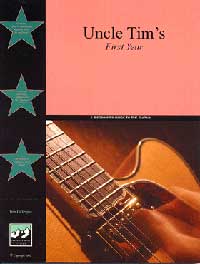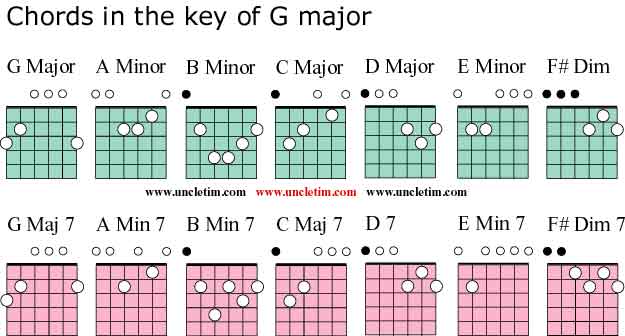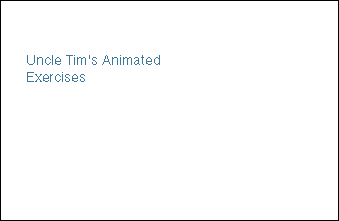

by Tim Gillespie
Get Your Musical Foundation In Place Now!
If you are struggling to know what chords are in what key or how the basic scale works within a key, you might be struggling when just a little information might make a HUGE difference.
You don't have to become a rules freak, but taking a little time to understand how a key works can take away ALL of that FRUSTRATION! And this is done visually so you do not need to read volumes to get it, just one thin book (88 pages).
Not knowing can stop your music right now and only understanding can make up for it. For $15, you can put this all to rest right now. Pick up a copy today.
eBooks are delivered instantly!
Major Chords in G Major



Minor Chords in G Major



These exercises are meant to help you see chords inside a key and start the process of interaction. These exercises are beginner to intermediate, however you can easily increase the complexity to create much more advanced exercises.
Note: At the time this article was written, some browsers, namely FireFox do not refresh and restart these animations correctly. If you experience this, consider using another broswer. Maybe by the time you read this, this problem will be taken care of.
The first exercise involves identifying the chords inside
the key. This exercise has a small twist. You will play two forms of each
chord. The standard chord and a seventh version of the chord.
Notice the chords based on the D minor seventh and the F# Diminished are very similar.
I advise starting by playing the open string G major scale first, just to get your ears registered in the key. The F# dim contains a note not in the scale. The animation uses a slightly different chord.
To restart the animation, hit your browser refresh button.
Here is a listing of the chords played in the animation.

The G Major Chord
To restart the animation, hit the refresh button on your browser.
In this animation you are going to play a simple G chord with a small run on the end of it. This starts with the G major chord. The run starts immediately after the chord and hits the notes F#, the open E note, D, C and ends with the open B note.
This is a pretty easy run but it should give you a chance
to mix single notes with a chord. You can always increase the difficulty
of this by extending the run and adding some more chords or longer runs.
Sit down with another guitarist and trade off playing the chord and adding a small riff at the end. Go back and forth.
Trying playing this run by adding a G note and using a pull off on the G and F# notes. This is a good way to spark your interest and compare your work to someone else's efforts.
Here is a listing of the chords in the key in case you want to experiment.
The E Minor Chord
To restart the animation, hit the refresh button on your browser.
 This run uses the E minor chord and then some three note
bursts. You can use pull offs with this run too. Just start with the first
note outlined on each string and pull the notes off until you get to the
open string notes.
This run uses the E minor chord and then some three note
bursts. You can use pull offs with this run too. Just start with the first
note outlined on each string and pull the notes off until you get to the
open string notes.
Try this same run with the other chords in the key.
Also try it by only using the G and open E notes on the last string. It can help to adjust the timing.
The C Major Chord
This one is a little trickier and you can play it a variety of ways. It is designed to be used as a pull off exercise. This exercise uses slightly more complicated routes.
